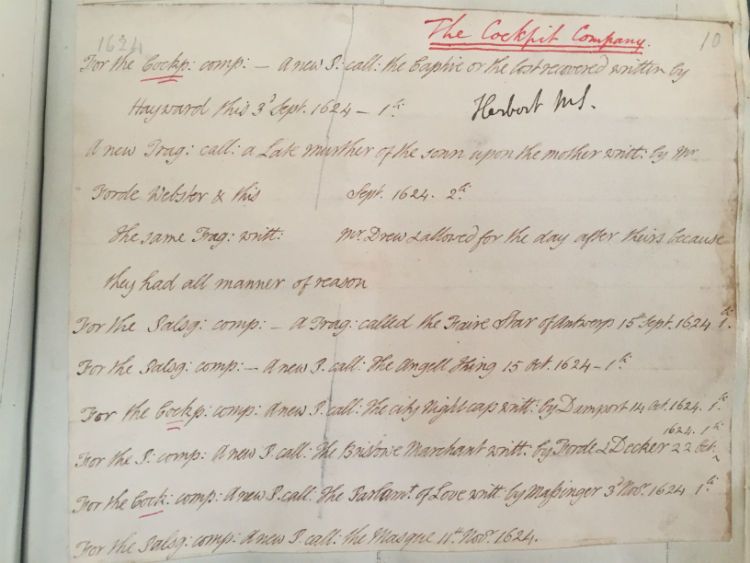Late Murder of the Son upon the Mother
Drue, T. (1624)
(See also: "Late Murder in White Chapel, or Keep the Widow Waking")
Historical Records
Dramatic Records of Sir Henry Herbert
J. O. Halliwell-Phillips transcribed a number of Sir Henry Herbert's licensing records and compiled them in various scrapbooks now held at the Folger Shakespeare Library. Amongst them is the following transcription of plays from September 1624:

A new Trag: call: a Late Murther of the sonn upon the mother writt: by Mr
- Forde Webster & this Sept. 1624. 2li.
- The same Trag: writt: Mr. Drew & allowed for the day after theirs because
- they had all manner of reason.
(NB. Bentley notes that the fee paid was "double the one usual at this time for licensing a new play. This double fee may be explained by an unusually large number of alterations or by the difficulties suggested by the licence of a second play on the subject by Drew. I take this second licence—which was not copied by Chalmers or Malone—to indicate that two different companies prepared plays on this topical subject at the same time; that Herbert, after hearing arguments, allowed both plays so that they could be acted in competition; that for unspecified reasons he allowed the Dekker, Rowley, Ford, and Webster play a one-day advantage. … [I]t is clear that the subject was thought to have great appeal and that two London companies were competing for the right to exploit it." Bentley 3.253-54).
Theatrical Provenance
Uncertain; perhaps the Palsgrave's company at the Fortune, given Drue's authorship of "Love Me or Love Me Not" (also in 1624) for that company.
Probable Genre(s)
Topical drama; domestic tragedy.
Possible Narrative and Dramatic Sources or Analogues
The murder of Joan Tindall by her son, Nathaniel Tindall, is known through the following sources:
Court records
From the records of the Middlesex Sessions, Sisson establishes that “Nathaniel Tindall or Grindall, of Whitechapel, yeoman, murdered Joan Tindall or Grindall on 9 April 1624 in Whitechapel. He came to trial at the Old Bailey at the Gaol Delivery from Newgate, along with Tobias Audley, on Friday, 3 September” (55). The motive was unknown, and there was no record of a Coroner’s Inquest. From the Grand Jury's True Bill, Sisson extrapolates the central features of the crime:
It appears from this that Tindall assaulted a certain Joan Tindall with a knife of iron and steel, striking her in the throat and in the left breast. The second wound was mortal, and she died instantly. The jury returned a Bill of wilful murder. The words above the Bill were written after the trial and record the judgement. Expanded and translated [out of Latin], they run thus, 'having pleaded guilty, he was sentenced to be hanged near the house where he committed the murder'. (Sisson 56)
Ballads
There were also two ballads written on the subject, which were registered at Stationers' Hall:
2 July 1624
(S.R. I, 4.120)
| Richard Hodgkins. | The repentance of NATHANAEL TINDALL that kil[le]d his | |
| mother . . . . . . . . . . . . . . . . . . vjd |
16 September 1624
(S.R. I, 4.123)
| John Trundle | Entred for their Copie vnder the handes of master DOCTOR WORRALL | |
| Richard Hodgkins. | and master Lownes Warden A most bloudy vnnaturall, and vnmatchable | |
| murther Comitted in Whitechappell by NATHANAELL TINDALL | ||
| vpon his owne mother written by JOHN. MORGAN . . vjd. |
The first of these is extant: The penitent Sonnes Teares, for his murdered Mother (EEBO-TCP, Open-Access), purportedly by “Nathaniel Tyndayle, sicke both in soule and body: a prisoner now in New-gate” (57).
References to the Play
The only unambiguous reference to Drue's play is the licensing record; other discussions of the subject matter (see The Late Murder in White Chapel, or Keep the Widow Waking) may possibly refer to Drue's also.
Critical Commentary
Critics are reluctant to acknowledge that there appears to have been two plays written on precisely the same subject matter; the more famous of the two is second play on this subject, "The Late Murder in White Chapel, or Keep the Widow Waking", because it was the subject of Star Chamber attention. Harbage conflates this title with the second play on this subject. Sibley maintains separate entries but confuses the details (attributing the current play to Ford and Webster -- to whom she also ascribes the second play -- without recording Drue's contribution to either).
For What It's Worth
The wording of the licensing note implies that Drue's play, bearing the name "a Late Murther of the sonn upon the mother", might only have dealt with the tragic material (the Tyndale murder) rather than the "comic" plot of the other play: the abuse of the widow. This is of course entirely conjecture, and if the Star Court documents for the Dekker/Ford/Rowley/Webster play did not exist, we would not know about the "Keep the Widow Waking" portion of that play.
Works Cited
Site created and maintained by David McInnis, University of Melbourne; updated 30 March 2016.